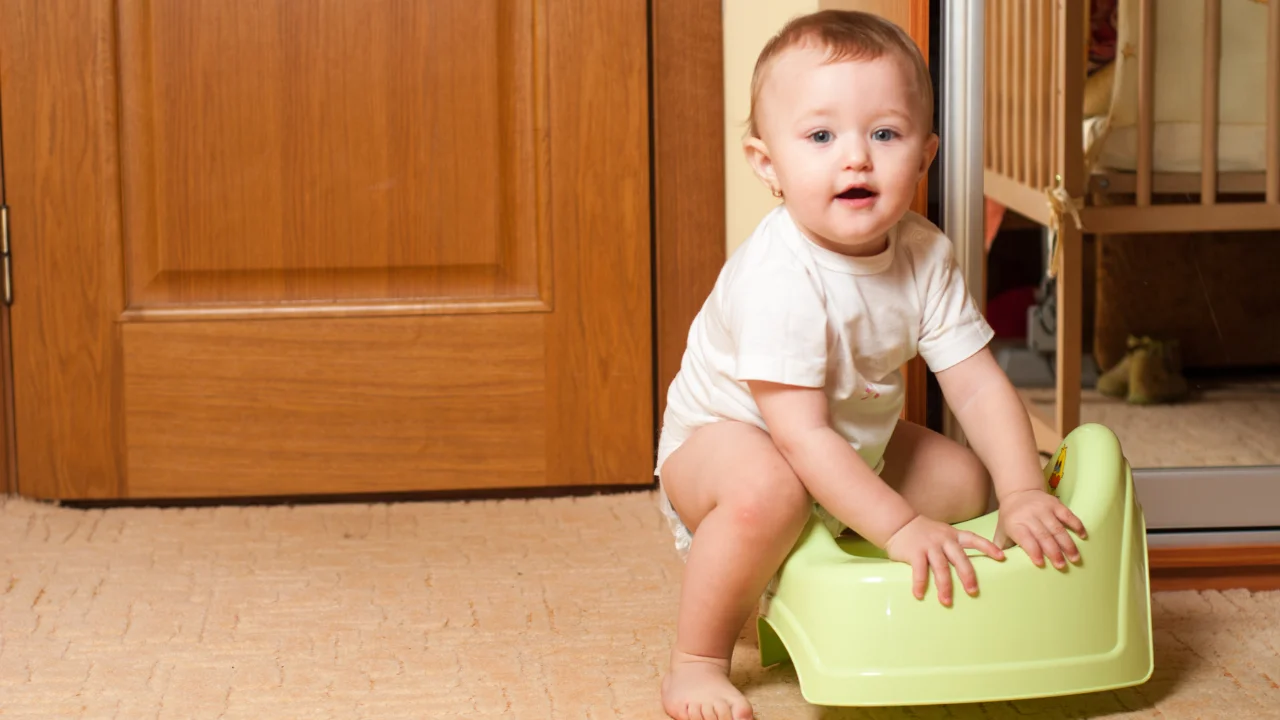
በዚህ ጽሑፍ ውስጥ
- What is infant potty training?
- What are the advantages of infant potty training?
- What are the disadvantages of infant potty training?
- Does infant potty training work?
- How can I get started?
What is infant potty training?
Also called “elimination communication” or “natural infant hygiene,” infant potty training is the practice of introducing your baby to the toilet or potty at a very early age – usually between birth and 4 months.
Some parents who do this avoid diapers completely by racing their baby to the nearest bathroom whenever they anticipate a poop or pee. Others use diapers on and off. By 18 months, in most cases, their children have “graduated” – that is, they know when they have to use the toilet and get themselves there successfully.
While the notion of potty training a very young infant seems radical, it’s not a new idea. Before 1950, most children in USA were toilet trained by 18 months. And today, most African, Asian, and European babies are trained well before their second birthday.
What are the advantages of infant potty training?
There’s little scientific data on toilet training in general, much less on infant potty training. But proponents claim many advantages:
It promotes parent-baby bonding. Advocates assert that infant potty training brings you closer to your baby. Because you’re constantly watching your baby for signs of being about to eliminate, they say, you become more in tune with his needs.
Parents who use the technique are also likely to embrace attachment-style parenting – an approach to childrearing that encourages practices like the family bed, prolonged breastfeeding, and carrying your baby close in a sling.
It’s more comfortable for your baby. Infant potty training advocates believe that babies often cry and fuss because of diaper discomfort, even when they’re wearing disposables, and that you can spare your baby rashes by allowing him/her to go diaper-free.
It allows your baby to exert his growing independence. As he/she becomes more mobile and starts wanting to do things his/her own way, it can be easier to encourage him/her to “crawl to the potty” or “go use the big boy/girl toilet” on his/her own than to engage in daily diaper change battles.
It reduces diaper waste. According to the Environmental Protection Agency, disposable diapers last for centuries in landfills, and a typical baby goes through about 8,000 of them. Using fewer cloth diapers helps the environment, too, since those require energy and other resources for washing and delivery. And reducing your diaper use isn’t just good for the earth; it’s a nice break for your family’s budget.
It’s normal and natural. Infant potty training mimics the time-worn practices of women in parts of Africa and Asia, where mothers often carry around their undiapered babies. These moms manage to avoid being soiled by their bare-bottomed children by learning to anticipate their elimination needs: When a mom notices a signal or pattern that suggests her child is about to relieve him/herself, she holds him/her away from her body.
What are the disadvantages of infant potty training?
Various experts are skeptical of the approach, and the effort involved may be too much for many parents:
It takes lots of time and dedication. While infant potty training enthusiasts say you don’t have to use the technique around the clock for it to be helpful – you can let your baby go diaper-free just during a certain time of day, for example, or only when you’re at home – you’re more likely to succeed if you use the technique as often as possible.
This means infant potty training can be hard to do if you’re a working parent, particularly if you and your partner both work full time. And no daycare facility would be willing – or permitted under licensing restrictions – to enroll a diaperless infant, nor would many babysitters consider this a part of their job description.
Your baby might not be physically ready for it. A set of child development experts, say that babies are just starting to be aware of the sensation of a full bladder or rectum by 12 months old and have only slight control of their bladder or bowels by 18 months.
Expect trip-ups along the way. Infant potty training isn’t always a snap. Online community forums are full of notes from parents who find the process difficult and exasperating. Some babies use the potty for a few weeks, then go back to having frequent accidents; others eliminate without ever giving a signal; and still others stop having bowel movements.
Pediatrician also cautions that parents should watch out for whether they’re getting frustrated with their children. “Infant potty training is a form of conditioning, much like how Pavlov conditioned dogs to salivate at the ringing of a bell. I worry that for children who aren’t easily conditioned, the process can create negative parent-child interactions.”
Be prepared for messes. With infant potty training, accidents are par for the course. While advocates insist that the approach is overall less messy than diapers, you’ll want to be ready with cleaning materials for the times when your baby’s signals don’t work perfectly or you can’t quite get him to the potty in time.
Does infant potty training work?
That depends on what you mean by “work.” If your goal is to use fewer diapers and get your baby practicing a skill that he’ll certainly use later, the answer is yes. If your goal is to have a young baby who never needs diapers again and never has an accident, the answer is probably no.
Given parents’ success stories, some babies apparently can learn to read their bodies’ signals and get themselves to the potty as soon as they’re mobile – but undoubtedly others will need more time to develop the skill (or, perhaps, the interest). There’s no way to know how it’ll go for your child unless you give it a try.
If your main goal is getting your child trained sooner than average, that’s something you can attempt whether you use the infant potty training method or the more common approach. If your child isn’t taking to it, though, it’s probably worth waiting until he exhibits signs that he’s ready.
How can I get started?
It’s best to start between birth and 4 months, according to those who’ve used infant potty training. (If you start with an older child, it may take longer for him to learn, as he’ll have to “unlearn” his diapering behavior.) Here are the basic steps:
Watch your baby and get to know his elimination patterns. When and how often does your baby go to the bathroom? Does he always go at a particular time of day – right after waking up, for example? Does he make any particular noises, gestures, or expressions when he has to go?
When your baby makes one of his typical elimination signs, hold him gently over a toilet, a potty, or even a bucket or pot, which may better suit his tiny size.
While he’s relieving himself, make a noise that your baby will learn to associate with elimination (many parents use ssssss or some other waterlike sound; others use a word or phrase like “go potty”).
Repeat this sound or phrase whenever you see that your baby has to go, and also while he’s going, so he’ll learn to recognize it as a signal and connect his own impulses with the act of using the potty.
When an accident happens, be matter-of-fact about it and stay relaxed. Advocate and mother of five Parise says your attitude helps your child stay relaxed about the process, too.
During the nighttime, keep a potty right by the bed and put your baby on it before nursing or if he’s restless during the night. Some advocates say that babies rarely pee or poop during a deep sleep and will usually become restless or give some sort of sign sufficient to wake a parent when they need to go – assuming that you’re co-sleeping.
Be flexible. You don’t have to be a purist to practice infant potty training. As mentioned above, it’s fine to use diapers sometimes (at night, or when you’re out, for instance) if it makes life easier. If you can, use cloth diapers, since disposables are so absorbent that your baby often won’t realize when he’s wet or soiled.
Stay positive. Don’t use pressure or punishment. However and whenever your child learns to use the potty, training should be gentle and positive, and done with a sense of humor. The goal is to help your child get in tune with his body and feel good about using the potty.
ተጨማሪ ያንብቡ


Add a Comment